A vintage Minolta 16mm kit
A mention of 16mm Minoltas reminded me that a few years ago I found a perfect kit – without outer box or instructions, sadly – at an antique fair. A daylight developing tank for the film turned up in the closing-down stock from Konica Minolta’s warehouse. I decided they should really find a new home together via the normal eBay route, but before they went, a studio shoot was needed to record them for our virtual museum.
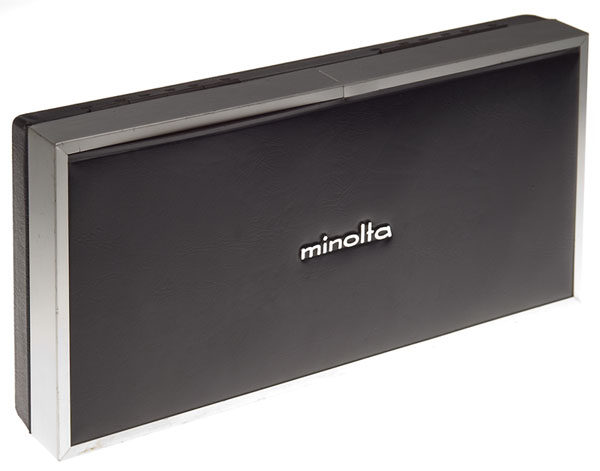
The box itself is typical 1970, with the look of leather, metal and velvet but really plastic throughout. The MG-S is one of the last Minolta-16 cameras produced, a flagship model with an impressive shutter speed range (1/30th to 1/500th), an f/2.8 23mm Rokkor lens stopping down manually to f/16 using a needle indicator shared with auto CdS metering, and an enlarged 16mm format of 12 x 17mm. This is almost identical to the FourthThirds system digital format, what we now call a 2X crop factor, making the lens equal in angular coverage to a 46mm objective on full frame 35mm.
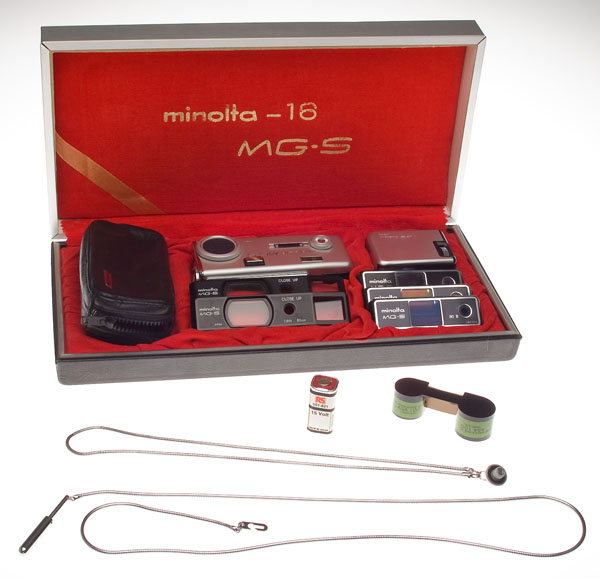
Inside the presentation case we find a flashgun (always sold with the camera, taking bulbs, not electronic) and leather pouch case with slinky metal lanyard strap. Extras for this deluxe outfit included two parallax-corrected close up attachments for 80cm and 40cm respectively, together with a special measuring chain you attach to the camera and use full length or halved to establish distances for close-ups. The camera already features a sliding built-in close up lens which switched the focus, dependent on depth of field, from hyperfocal infinity to 1.2m. Today we would be more aware that true focusing should have been fitted. Three filters were included – Haze 1A which is a fairly strong pink, 2X Yellow for black and white work, and 80B for shooting colour negative film by tungsten light.
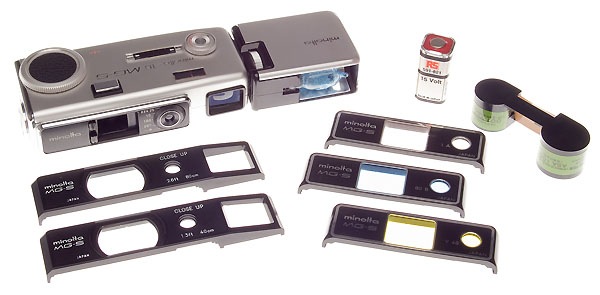
The camera is nothing if not finely styled. The texture and feel of the metal body are equal to the best of today’s pressed stainless steel digital cameras, and although it looks like satin plated brass, the machining of the end where the flashgun attaches is exactly like modern steel. The opposite end is chromium plated. Plastic features extensively but it’s mainly trim or used for the accessories c/u lenses and filters, and anything which looks like chrome plating is on metal.
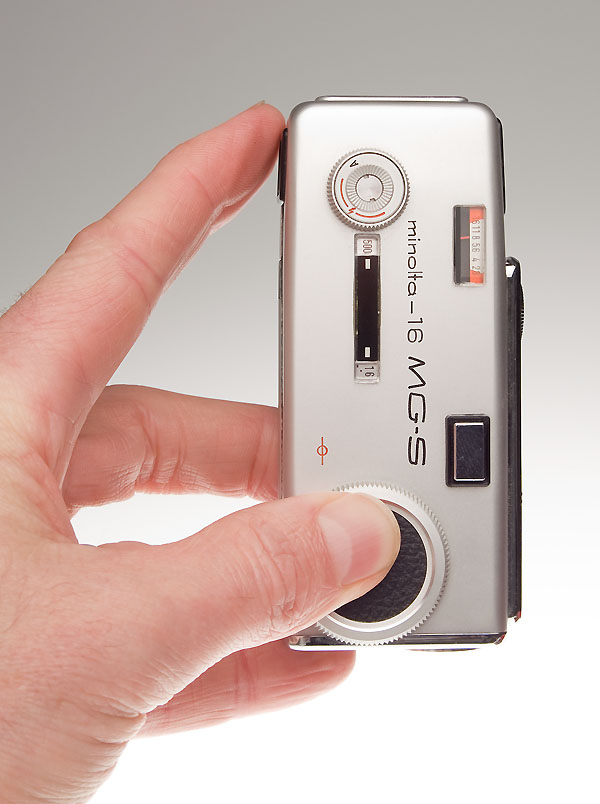
Not so long after this camera appeared, Kodak introduced the 110 format and in 1976 Minolta created the 110 Zoom SLR. 16mm film became a special interest for subminiature camera enthusiasts – see www.submin.com. The camera has a tripod socket in the bottom end as shown here, and a PC sync flash socket in the top end. The lens has a sliding cover as well as the sliding close-up lens, and when you use either, a red section appears in the viewfinder to crop it for parallax and/or warn you about shooting with the lens cap on. But it doesn’t obscure the finder any more with the cap over than it does with the CU lens over!
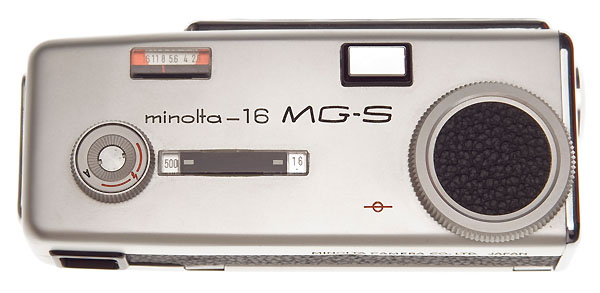
The large wheel at the right is the film advance, and the ’16’ displayed in the window opposite the ‘500’ is not an aperture – it is the number of frames left! This slightly confusing bit of design is a rare flaw from Minolta. The aperture is set by turning the thumb pressure centre of the left hand ring, against the scale in the metering window. The shutter speed is set using the outer rim of the left hand ring. The CdS metering uses a mercury cell which is hidden in film compartment.
Would I try to use the camera? No. I don’t have a 16mm subminiature carrier (or even a 110 carrier) for my enlarger, and my darkroom is non-functional these days. But the developing tank opens interesting possibilities for black and white.
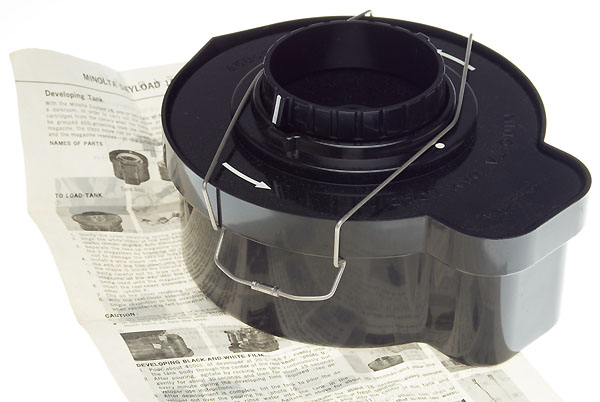
The instructions are in Japanese and English only, and the tank requires a staggering 450ml of solutions for the tiny film format. I work out that with many developers you could be re-using the diluted mix fifty times… if the agitation did not aerate it so well it died of exhaustion after two or three uses. The daylight loading tank requires you to break the rare super-16mm cartridge in half, and winds the film into a single curved track round the middle core of the doughnut-shaped tank. There is no spiral reel and no Correx apron. The tank is held together by a big metal clip, and the large knurled part in the centre does not screw it closed. It pulls the film out of the cartridge and wraps it emulsion-side out into its groove.

The box for the tank is old a battered, and I reckon it may have survived the fire which hit Japanese Cameras Ltd in Hempstalls Lane, Newcastle-under-Lyme, in the mid 1970s. The stock which was left a bit grimy but otherwise perfect was inherited by Minolta (UK) Ltd and taken to Blakelands, Milton Keynes, in 1981. There it stayed until being removed to Konica Minolta UK, Feltham, Middlesex, in 2005 when the Milton Keynes warehouses were closed. Finally it came to us in Scotland in April 2006 when KM closed the photographic division and we made an offer for all the rubbish in the warehouse which no dealers wanted to buy. The tank had probably been ‘in stock’ for over 30 years, but if anyone had ever asked for such an item, you know what the answer would have been!
Along with hundreds of thousands (literally) of old Minolta items dating back right into the 1960s it would have been invisible to any sales department and known only to warehouse stockmen whose job was to move it round occasionally. It is, finally, back with a camera it belongs to.
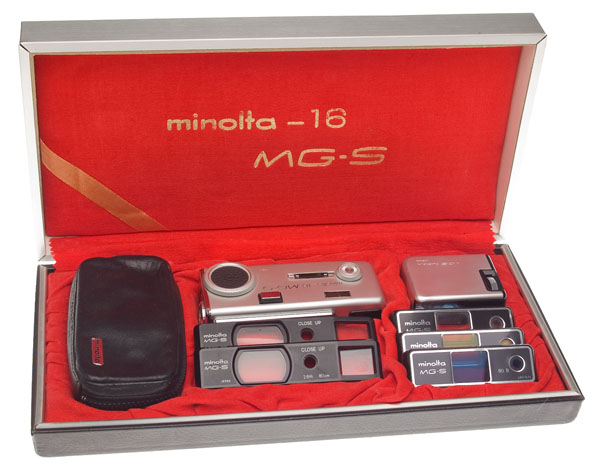
The chances of 16mm kits surviving in good condition are high, because the cameras were never all that practical and often sold for vanity reasons as a clever ‘spy camera’ to people who did not understand their limitations (at least, in the hands of inexperienced users) or the costs of processing. Excellent compact 35mm cameras were about to flood the market, 110 was coming. Even so it was good to find such a complete kit intact, and now it’s time for it to find a new owner.
– David Kilpatrick
